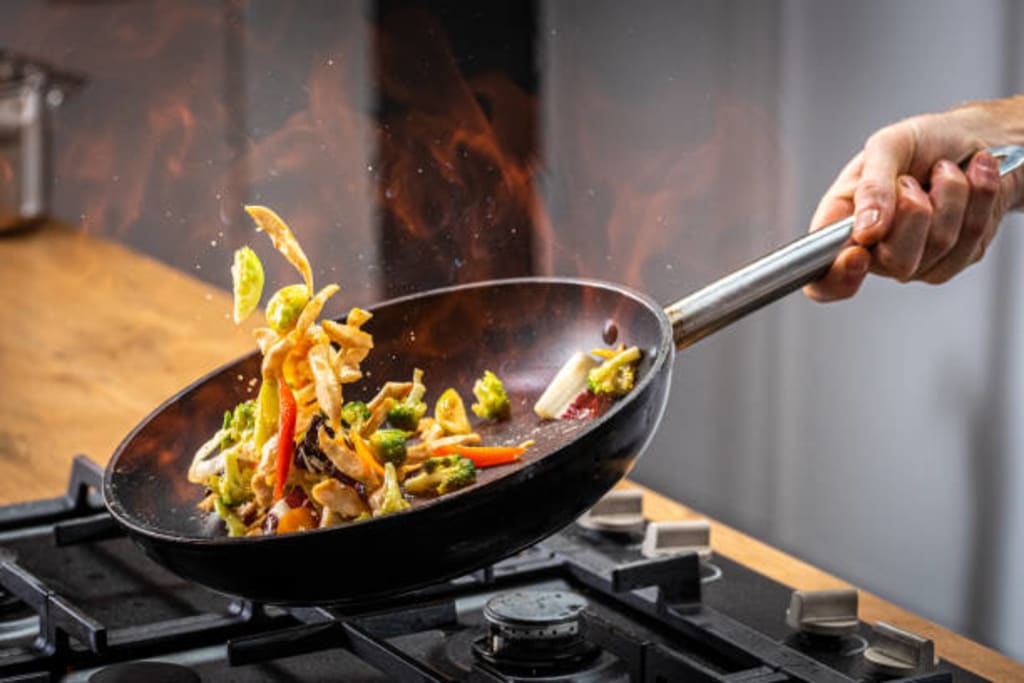Kitchen Hacks to Save Time, Get Organized, and Stay Calm
So maybe you think you’ve got it all figured out. You’re the MacGyver of the kitchen — spatula in one hand, two eggs in the other.

Crack, separate, and plop goes the egg in the bowl… with a bit of shell. The horror! What do you do? Hint: Fishing around with a spoon isn’t the answer.
Thankfully, we have a solution to your egg quandary (see tip number 10), plus quick fixes to tons of other food prep, cooking, and baking predicaments, from pitting a nectarine to softening butter the easy way.
We’ve hacked your kitchen — prepare to save money, save time, and never cry from cutting onions again.
Kitchen hacks for food storage
1. Keep potatoes white
Cover shredded or diced potatoes with cold water before cooking to prevent the spuds from turning that gross grayish/brown caused by the release of a starch that makes them oxidize.
2. Slow down rotting
Store tomatoes stem end down to keep them from spoiling as quickly. This prevents air from entering and moisture from exiting the scar where the tomato once attached to the vine.
Oh, and the advice to never store a tomato in the fridge? Debunked! Recent research revealed that the method of storage (fridge versus countertop) didn’t significantly affect taste or juiciness of tomatoes.Trusted Source
3. Give bananas a longer life
Keep bananas fresh for longer by wrapping the end of the bunch with plastic wrap. Better yet, separate each banana. Both tactics block ethylene gases from releasing out of the stem, thereby ripening the fruit too fast.
4. Speed up ripening
Be a total magician and morph a banana from green to yellow (or a peach from crunchy to juicy) with the help of a paper bag. When fruit is tossed into the bag, concentrated ethylene gas helps it ripen faster.
5. Save cut fruit from browning
You’ve probably heard that a little squeeze of lemon juice can keep apple slices from looking unappetizing. A mixture of 1 part honey to 2 parts water works much the same way to keep fruit from browning.
Ever wonder why this works? The citric acid and vitamin C in lemon juice and a peptide in honey slow down the oxidation process that causes discoloration.
6. Prevent brown sugar from hardening
Ugh, the worst: You go make cookies, only to find your brown sugar hardened into crusty nuggets (or a single rock-hard candy mountain). Help brown sugar stay soft and scoopable by tossing an orange peel or a slice of apple along with the sugar into an airtight container.
Or, for a quick fix, microwave brown sugar next to a small glass of water. The moisture the water released into the microwave will help break up the block of sugar.
7. Avoid plastic wrap disasters
Had enough of wrangling plastic wrap? Store the roll in the fridge to cover leftovers with less of a hassle. Chilling the wrap temporarily reduces its stickiness.
8. Get creative with covering food
They’re known for hair hackery, but shower caps’ usefulness isn’t limited to keeping your lovely tresses dry. Cover leftovers with a clean cap (right in their dishes) to prevent air particles from turning food stale.
Not only are shower caps reusable, they’re a heckuva lot easier than repeatedly removing and replacing plastic wrap or tin foil. And they just might make you giggle when you see them in your fridge.
9. Check if eggs are still (incredibly) edible
Your nose alone won’t always tell you if eggs have gone bad. To find out, gently place uncooked eggs in a bowl of cold water. If an egg sinks to the bottom, it’s A-OK. If it floats, it’s seen better days.
Over time, the liquid inside eggs evaporates through the porous shell, leaving a gas bubble inside. The floatier it is, the older it is.
Peeling, pitting, and removing
10. Never wrestle eggshell pieces again
No one likes crunchy pieces in their cake or brownies. But grabbing a bit of eggshell that’s fallen into batter can turn into a wild goose chase, as it seems to squirm out of your reach like a wily tadpole.
We’ve got two solutions. For one, just wet your fingers and reach right in. (Simple, but it really works!)
For a cleaner alternative, scoop up bits of broken eggshell with half of your already-cracked egg. The shell acts as a magnet to draw up shell pieces without wasting too much egg.
11. Easily scoop out squash seeds
Remove seeds from vegetables like squash and pumpkin with an ice cream scoop. Because the edge of the scoop is sharp, it cuts through the fibrous, gooey stuff inside the squash better than your hand or a regular spoon.
12. Skim the fat
Spoon out excess fat from stocks, stews, and sauces by skimming a few ice cubes (wrapped in a paper towel or cheese cloth) along the surface of the liquid. The ice helps the fat solidify, making it easier to remove with a spoon (or even a piece of toast).
13. Separate yolks from whites
This hack is borderline wizardry!
Crack an egg into a bowl, then invert an empty water bottle above the yolk, squeezing in the sides of the bottle. As the mouth of the bottle makes contact with the yolk, release the pressure on the bottle.
Schloooop! The change in air pressure sucks the yolk directly into the bottle, leaving the white behind.
Need a tutorial? Check out this video.
14. Pit cherries with ease
Place cherries on top of an empty beer bottle, one at a time, and use a chopstick to push the pit into the bottle.
15. Flip that banana upside down
Ever had issues prying into a banana? You’re not alone. Instead of wasting precious fruit by hacking into the stem end with a knife, gently press the bottom together and peel the banana from the bottom up.
16. Peel that papery skin from ginger
No need to pry off ginger’s knobby skin with a peeler. Ginger root skin is actually quite delicate and can be scraped off with a teaspoon.
17. Peel garlic the fuss-free way
Remove all cloves from the bulb, then whack each clove with the side of a chef’s knife. The skin will fall right off.
18. Peel citrus fruits without the mess
There’s only one downside to eating an orange: the tedious task of peeling it. To avoid the mess and frustration, roll citrus fruits and/or microwave them for a minute for easy peeling. (Just be careful to not burn yourself!)
19. Peel potatoes without a peeler
Time to ditch the peeler again! Peel a potato in a snap by boiling it for a few minutes, then giving it an ice bath — a method known as blanching. The skin will separate from the potatoey center so you can pick it right off.
20. Pit stone fruits with a twist
Cut stone fruits, such as plums and nectarines, into two equal halves, then twist the halves in opposite directions. Use your thumb to pop out the pit.
If your thumb doesn’t do the job, gently pry it out with a butter knife, or cut the fruit into quarters for easier separating.
21. Peel boiled eggs in a big batch
Time to put all your eggs in one basket — or, uh, one pot or other crockery.
Peel multiple hard-boiled eggs at a time by shaking them in any lidded container. Smash, bang, boom! Shells are cracked and ready to shake right off.
The eggs won’t be pretty, but they will be ready for an egg salad much quicker than traditional methods.
22. Make eggshell removal even easier
The fresher your eggs, the harder it is to remove their shells when hard-boiled. Solve this predicament by adding baking soda or vinegar to water when boiling eggs.
Both substances permeate the eggshells and help the albumen (that’s fancy speak for egg whites) separate from the shell.
23. Pit and peel an avocado with just one utensil
Cut an avocado into quarters lengthwise to break the fruit from the pit. (Once it’s down to the last section, you can just pop the pit right off.) Run a knife under the tip of skin on each section, then peel it off like a banana.
24. Hull strawberries
Though you technically can eat strawberries whole, most of us would rather not.
Press a straw through the bottom of a strawberry until it breaks through the top and takes the hull — the white part of the center of the berry — with it. Remove any remaining leaves with your fingers.
25. Make citrus fruits even juicier
To get the most juice out of a lemon, refrigerate, then microwave it for 15 to 20 seconds.
Bonus tips: Roll citrus fruits before squeezing, cut them lengthwise, and/or use a pair of tongs to squeeze instead of your own two hands.
26. Keep seeds from falling into citrus juice
When juicing citrus, wrap the fruits in cheesecloth (or a clean stocking) for seed-free sipping.
27. Remove pomegranate seeds (without dying your hands red)
The nitpicky nature of pulling out pomegranate arils is almost enough to make you pass on these delicious, antioxidant-rich fruits.Trusted Source
Simplify the process by cutting a shallow circular cone into the flower end of the pomegranate, then slice off the bottom (the other side) of the fruit.
Score the fruit along its natural ridges, and pry each section apart to reveal the seeds.
28. De-kernel a cob of corn without your teeth
Use a bundt pan — yes, really — to slice corn kernels off the cob. Place the pointy end of the cob on the center hole of the pan (with the open part of the pan facing up) and gently press downward. The pan does double duty as both a stand and a kernel collector.





Comments
There are no comments for this story
Be the first to respond and start the conversation.